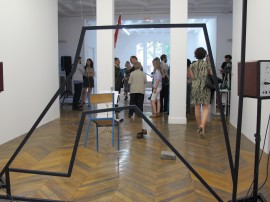Invisible Monuments
“The most striking feature of monuments is that you do not notice them. There is nothing in this world as invisible as monuments. They are no doubt erected to be seen – indeed to attract attention. But at the same time they are impregnated with something that repels attention. Like a drop of water on an oilskin, the attention runs off them without stopping for a moment.” It is with these “ill-tempered observations” that Austrian writer Robert Musil addresses the impossibility of perceiving monuments in his Posthumous Papers of a Living Author. 1
The “Invisible Monuments” exhibition takes Musil’s paradox of vision and attention as its starting point: monuments, while intended to attract the eye, are in fact imperceptible and “gaze-repellent” – refractory to both the eye and the understanding. They exist, but are not alive. They occupy a space both real and ideal, but are empty, transparent, indeterminate. At variance with our senses, they slip from view. What does this imply for those great tributes to the past, those statues of heroes and those buildings dedicated to “memorable” moments? Where are the traces of those who have gone before us, our exemplars for the present and the pillars on which to build the future?
The works by the artists taking part in this exhibition challenge the notion of the monument: its function, value and meaning in today’s world. This critical conjecturing has its roots in an artefact that has always been characterised by a powerful symbolic charge and conspicuous conceptual depth. The monument is not merely an artwork or a piece of architecture set in the public space: it is above all intended as an embodiment of a memory, a repository for personal or group recollection, a bearer of a message through time, a link between epochs. It is an artefact which, as Aloïs Riegl wrote in his famous work on the subject, intentionally or involuntarily embodies a “memory value”. 2 Etymologically speaking the word “monument” contains the root of the Latin verb monere, whose meanings include to remind, exhort, punish and inspire. Thus the word opens up a broad range of potential acts, a value field reflected in the monument’s plurifaceted identity.
The coordinates of space and time are to be found within a system that is running out of immutability. Our recognition of the fragile, unpredictable nature of this mechanism, based on an incomplete relationship between form and substance, spatiality and temporality, not only calls into question the meaning of the monument, it also contests the value of its content. Are history and memory still “visible”? If not, where have they gone? Are there still images, ideas, words and voices capable of filling the monument, of replenishing its empty volume? Or, as Rosalind Krauss has put it, are we not now faced with “a history of failure” 3
The participating artists challenge and criticise the concept of the monument, pointing up its instability and suggesting both new interpretations and hitherto untested interconnections with history and its traces. They speak to us about the past and memory as shifting elements, endowed with a variable, flexible identity and the blurry contours of truth and fiction, of forgetting and remembering.
The traditionally affirmative function of the monument – celebration and commemoration of a past given material existence in the present and projected forward into the future – is supplanted here by new modalities based on questioning, doubt and critical scrutiny. What once was presence turns into absence; what once took the form of an affirmation becomes a question.
The pars destruens of the project nonetheless does not exclude an imaginative, constructive urge which injects life into images, shapes, spaces and ideas capable of generating a meditation on the past, a reflection on “today”, a narrative looking to the future. The monument has not vanished: by assuming other forms it still shows through on a secret, hidden stage, clad in a new, magical robe woven from questions and doubts rather than truths taken for granted. Suspended between visibility and invisibility, this dreamlike image recalls the lines by American poet Mark Strand: 4
The Monument
You will see it
in the shade or covered
with a shawl
of sunlight or sheen
of wet gray ;
or later, barely
visible while
the night passes
with its silent cargo
of moons and stars.
You will see sleeping
figures at its feet ;
you will see
in its bleached eyes
baked by the sun,
strafed by rain,
the meanness of
the sky ; and in
its barely open mouth
perpetual twilight.
You will see it
when you come
and when you leave,
you will see it
when you do not wish to
and you will never know
whose monument it is
or why it came to you.
Text by Costanza Paissa
This translation has not been published in a French edition. The English text has been translated by the La Galerie team for the exhibition.
1. Robert Musil, Oeuvres pré-posthumes, Éditions du Seuil, Paris 1965, p. 78.
2. Aloïs Riegl, Le culte moderne des monuments : son essence et sa genèse, Éditions du Seuil, Paris 1984.
3. Rosalind Krauss, “Échelle/monumentalité, modernisme/postmodernisme. La ruse de Brancusi”, in Qu’est-ce que la sculpture moderne ?, catalogue d’exposition, Centre Georges Pompidou, Paris 1986, p. 246-253.
4. Mark Strand, The Monument, Ecco Press, New York 1978.
around the exhibition
-
01/01/1970
Performance The Fallen Reply by Iris Touliatou with the participation of Katerina Fotinaki and Tolgay Pekin.
-
01/01/1970
Two-voices tour of the exhibition by Costanza Paissan, curator and Marie Cozette, director of the Contemporary Art Center – La synagogue de Delme.
